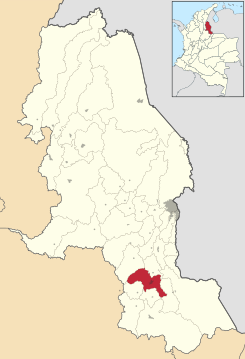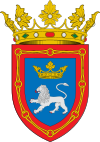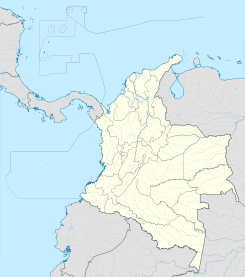Pamplona, Norte de Santander facts for kids
Quick facts for kids
Pamplona
|
|||
|---|---|---|---|

Pamplona
|
|||
|
|||
| Nickname(s):
Student City, Miter City, Holy Spirit Valley
|
|||

Location of the municipality and town of Pamplona, Colombia in the Norte de Santander Department of Colombia.
|
|||
| Country | |||
| Department | North of Santander | ||
| Founded | 1549 | ||
| Area | |||
| • Municipality | 298.3 km2 (115.2 sq mi) | ||
| • Urban | 5.27 km2 (2.03 sq mi) | ||
| Elevation | 2,342 m (8,485 ft) | ||
| Population
(2018 census)
|
|||
| • Municipality | 50,025 | ||
| • Density | 167.700/km2 (434.34/sq mi) | ||
| • Urban | 46,013 | ||
| • Urban density | 8,731/km2 (22,613/sq mi) | ||
| • Demonym | Pamplonés | ||
| Time zone | UTC-5 (Colombia Standard Time) | ||
| Area code(s) | 57 + 7 | ||
| Website | Official website: http://www.pamplona-nortedesantander.gov.co/ | ||
Pamplona is a city and a municipality in Norte de Santander, Colombia. It is one of the most populated cities in the region. People sometimes call it "Student City" because of its large university. It's also known as "Miter City" due to its important religious history.
Contents
History of Pamplona
Early Days and Founding
Pamplona was founded on November 1, 1549. Its full name was Nueva Pamplona del Valle del Espíritu Santo. It was named after Pamplona, the capital city of Navarre in Spain. Pedro de Ursúa and Ortún Velasco de Velázquez were the founders.
From Pamplona, many expeditions set out. These trips led to the founding of other important towns. Some of these include Mérida, San Cristóbal, and La Grita in Venezuela. In Colombia, towns like Ocaña, Bucaramanga, and Cúcuta were also founded from here.
Native People
The first people living in this area were called the Chitareros by the Spanish. They got this name because the men often carried a gourd (a dried fruit shell). This gourd held a drink called chicha, which was a type of corn wine.
When the Spanish arrived in 1549, they set up a system called encomiendas. This system gave Spanish settlers control over groups of native people. About 100 groups of Chitareros were divided among 53 encomiendas across the land.
Growth and Importance
Pamplona's location was very important. It became a key trade route between the Spanish colonies in New Granada (now Colombia) and Venezuela. The region had very fertile land and lots of gold in its mountains. This made it one of the richest areas during the colonial period. It was almost as important as the province of Socorro. Because of this, Pamplona was a major political and administrative center for the Spanish crown.
Fight for Independence
Pamplona earned the nickname "Patriotic City" from Simón Bolívar. This was because it was one of the first places in New Granada to declare independence. On July 4, 1810, led by Doña Águeda Gallardo, Pamplona began its revolution. Full independence was declared on July 31 of the same year.
Later, between 1819 and 1821, Pamplona greatly helped the fight for freedom. It provided many people and resources to free Colombia and Venezuela. At that time, Pamplona was as important as Bogotá, the capital.
In 1910, the Norte de Santander Department was created. Pamplona became part of this new department. Today, Pamplona is still a very important cultural center. It hosts many national and international events. One of the most famous is Holy Week. Along with celebrations in Mompox and Popayán, Pamplona's Holy Week is one of the most important in Colombia.
Pamplona is located in the southwest of the Norte de Santander department. Its historic center is very special. It was declared a National Monument in 1963. For a long time, it has been a main educational center for eastern Colombia. It also attracts students from nearby parts of Venezuela. The city's religious celebrations are very serious and attract many visitors.
Climate and Weather
Pamplona has a mild climate. The average high temperatures are usually between 18°C (64°F) and 19°C (66°F). The average low temperatures range from 7°C (45°F) to 11°C (52°F).
| Climate data for Pamplona (Iser Pamplona), elevation 2,340 m (7,680 ft), (1981–2010) | |||||||||||||
|---|---|---|---|---|---|---|---|---|---|---|---|---|---|
| Month | Jan | Feb | Mar | Apr | May | Jun | Jul | Aug | Sep | Oct | Nov | Dec | Year |
| Mean daily maximum °C (°F) | 19.0 (66.2) |
19.2 (66.6) |
19.5 (67.1) |
19.5 (67.1) |
19.8 (67.6) |
19.4 (66.9) |
19.2 (66.6) |
19.7 (67.5) |
20.0 (68.0) |
19.7 (67.5) |
19.1 (66.4) |
18.8 (65.8) |
19.4 (66.9) |
| Daily mean °C (°F) | 13.9 (57.0) |
14.4 (57.9) |
15.0 (59.0) |
15.6 (60.1) |
15.9 (60.6) |
15.7 (60.3) |
15.4 (59.7) |
15.6 (60.1) |
15.7 (60.3) |
15.4 (59.7) |
14.9 (58.8) |
14.3 (57.7) |
15.1 (59.2) |
| Mean daily minimum °C (°F) | 7.9 (46.2) |
8.8 (47.8) |
9.8 (49.6) |
11.1 (52.0) |
11.6 (52.9) |
11.5 (52.7) |
11.1 (52.0) |
11.0 (51.8) |
10.6 (51.1) |
10.5 (50.9) |
10.1 (50.2) |
8.8 (47.8) |
10.2 (50.4) |
| Average precipitation mm (inches) | 31.8 (1.25) |
36.6 (1.44) |
64.4 (2.54) |
113.3 (4.46) |
106.2 (4.18) |
68.9 (2.71) |
58.7 (2.31) |
68.9 (2.71) |
102.7 (4.04) |
141.7 (5.58) |
95.1 (3.74) |
41.6 (1.64) |
929.9 (36.61) |
| Average precipitation days | 9 | 11 | 13 | 16 | 17 | 17 | 18 | 18 | 18 | 19 | 16 | 10 | 181 |
| Average relative humidity (%) | 79 | 79 | 78 | 79 | 76 | 74 | 73 | 73 | 75 | 78 | 80 | 79 | 77 |
| Source: Instituto de Hidrologia Meteorologia y Estudios Ambientales | |||||||||||||
Economy of Pamplona
Agriculture and Livestock
One of Pamplona's most important farm products is the potato. Other vegetables and fruits grown here include strawberries, garlic, carrots, wheat, beans, and corn. In 2014, Pamplona grew the most peas in the entire department.
For livestock, the main animals raised are chickens, cattle (cows), and pigs. The Pamplona region is a major food producer for the department. It also makes dairy products, especially cheese. Popular local cheeses include Cuajada, Queso Campesino (Farmer's Cheese), and Queso de Hoja (Leaf Cheese).
Trade and Tourism
About 85% of the businesses in Pamplona are involved in trade. This means many shops and services.
Pamplona is also known as a college town. It is home to the University of Pamplona. The university and tourism are the main economic activities today. Thousands of students live and eat in the city. They are the main customers for local shops, restaurants, and cafés.
Historic Sites and Museums
Churches and Religious Buildings
Many religious buildings in Pamplona were built a long time ago. Construction started in the late 1500s and early 1600s.
The Santa Clara Cathedral was built in 1584. It was built by Magdalena Velazco, whose father founded Pamplona. The cathedral has a very important pipe organ. This organ was made by Celestino Balbiani from Milan, Italy. The cathedral also features a beautiful Baroque-style altarpiece. In 1990, the architect Jaime Salcedo won an award for restoring the cathedral.
The Humilladero Sanctuary is a very popular place to visit, especially during Holy Week. It is a great example of old colonial architecture. Inside, you can see a well-preserved wooden carving of Jesus Christ. This sanctuary has been around since Pamplona was founded.
Museums and Historic Homes
Pamplona has several interesting museums. One of them is the Águeda Gallardo de Villamizar House. This house was built around 1644, after an earthquake. Águeda Gallardo lived here. She was an important woman who helped Colombia gain its independence. Historians say that this house was a meeting place for people to discuss the country's freedom.
International Connections
Sister Cities
Pamplona has a special connection with another city. It is a "sister city" with:
 Pamplona (Navarre), Spain
Pamplona (Navarre), Spain
See also
 In Spanish: Pamplona (Colombia) para niños
In Spanish: Pamplona (Colombia) para niños




